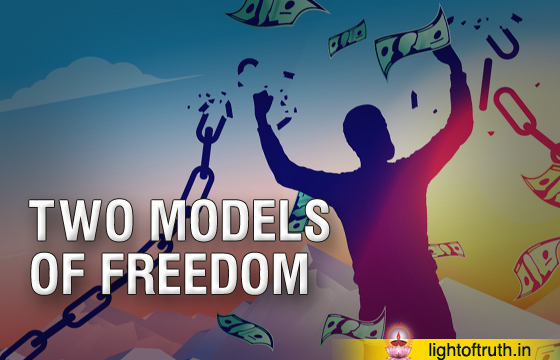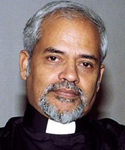Azadi ka Amrit Mahotsav Kolkata event honours four Clergymen
Pope Francis asks businesses to support working women: They’re ‘afraid to get pregnant’
Study: Christianity may lose majority, plurality status in U.S. by 2070
Indian politician declines Magsaysay Award under party pressure
Like John Paul II, Pope Francis heads to Kazakhstan during time of war

ValsonThampu
 There needs be no necessary correlation between the fanfare of freedom and the friendliness to freedom a people maintain. Put differently, the fact that the attainment of freedom is celebrated with aplomb doesn’t mean either that we understand freedom or value it. Rather, the more freedom proves elusive, the greater the need to celebrate freedom as a collective attainment. Celebration becomes, in that case, a hypnotic way of belying the reality.
There needs be no necessary correlation between the fanfare of freedom and the friendliness to freedom a people maintain. Put differently, the fact that the attainment of freedom is celebrated with aplomb doesn’t mean either that we understand freedom or value it. Rather, the more freedom proves elusive, the greater the need to celebrate freedom as a collective attainment. Celebration becomes, in that case, a hypnotic way of belying the reality.
Eternal vigilance, Nehru said, is the price a people need to pay for preserving their freedom. Vigilance is far more than restless alertness. An informed sense of responsibility to abide by the essence of freedom is basic to the vigilance mandated in this regard. Hyper-alertness, without an adequate sense of what one is required to safeguard, will only make us remain trapped in irrelevant wrangles.
It is noteworthy that there were two contrary approaches to the attainment of freedom for India. The hardliners and the moderators shared the same goal, but differed in their approaches. Underlying their different strategies were two different understandings of the nature and scope of freedom. While one section reposed faith in violence, toGandhi, violence endangeredfreedom. Even if the strategies of violence succeeded in driving out the colonial oppressor, violence was bound to perpetuate unfreedom for the vast majority of the people. In effect, one set of oppressors with be substituted with another. A society could be split in two; one section free to oppress, and the other, by far the larger section, obliged to endure the new oppressors. It is instructive, hence, to consider as for whom, and from what idea of freedom, the attainment of freedom is turned into a super carnival.
The problem with every form of celebration is that it excludes the need to understand what is being celebrated. Celebrations –that include even the celebration of the Mass- could become no more than stylised projections. Except to inner circles of specialists, the meanings and benefits of these celebrations remain hidden. So, their commemorative aspects have to be swamped by the choreographed ferver and festivity.
Jesus Christ saw himself as liberator. He came to set the captives free (Lk: 18). Human liberation was the authentic expression of who he was. He was the truth (Jn14:6). Truth of this kind is inseparable, according to him, from ‘the way’ and ‘the life’. This explains why certain means, no matter how plausible they seemed to the pragmatists of the world, were unacceptable alike Jesus and Gandhi. Jesus refused to secure ‘the nations of the world’ –as a short cut to liberating humanity from the yoke of the satanic- by worshipping Satan. Violence is the essence of the satanic. Hence the contradiction immanent in liberating the world from satanic oppression by worshipping Satan! Gandhi’s refusal to resort to violent means to expedite the attainment of India’s freedom was akin to this. It is logically consistent that the ascendancy of absolute faith in violence correlates to contempt for Gandhi as the Apostle of Non-violence, a point emphasised by Godse in his statement -Why I Killed Gandhi- to the court of appeal in 1948.
Culturally, violence is deemed manly. Country is feminine. State is masculine. State enjoys the exclusive right to use violence in pursuance of its goals. It is legitimate for State to use violence not only against the external enemies of a country but also against its citizens. Culturally, violence is macho. From ancient of days, man showed off his prowess through his capacity to inflict violence, cruelty and death on others. Man remains a hunter at heart. So, violence appeals powerfully to human nature. No wonder, war-mongering remains the sure-shot way to electoral success.
The worldly idea of freedom carries, within itself, seeds of unfreedom. In it freedom and bondage interpenetrate. In a system where everyone is free, the sheen of freedom lost to those who are hierarchical in their outlook and exploitative in their culture. They measure their freedom by the extent to which they constrict the freedom of others. Greeks and Romans alike chrished freedom above all, but neither culture could manage without a large army of slaves. Plato and Aristole justified slavery.
This leads us to a third crucial difference between the two models of freedom. The attainment of macho-freedom is celebrated vicariously as a token annual event. Such a celebration looks odd and meaningless vis-a-vis the Jesus-Gandhi model of liberation. In the case of Jesus, freedom leads to the sacramental model of service. It is Jesus, the Liberator, who celebrates the Fellowship Meal with his disciples, giving them a model to follow forever. It makes profound spiritual sense that the heart of this meal is the feet-washing ceremony. Freedom for all will remain a mirage, unless human beings outgrow the hierarchical worldview and embrace equality. Freedom and inequality cannot coexist.
This points to the core mission of the church: to exemplify what it means to be free as per the Jesus-mode. We must respect the flag, the national anthem, and share the national euphoria. But we must go farther. On the Independence Day, not less than on Maundy Thursday, we need to celebrate the Feet-Washing Sacrament. I do know that feet-washing is not recognized as a sacrament in many church traditions. I wonder why. Surely, it is basic to the ‘witness to the nations’ that Jesus mandated (Mtt.28:19).
Unless your righteousness exceeds, Jesus said, the righteousness of the Scribes and the Pharisees, you shall not enter the Kingdom of heaven. With equal validity we may say, unless our idea of freedom exceeds the worldly idea of it, we shall be like the salt that has lost its saltiness. Christians need to shift from the ‘band-wagon effect’ to the ‘leaven-in-the-lump effect’. The all-important question is not, ‘can we?’ but ‘shouldn’t we?’
Leave a Comment